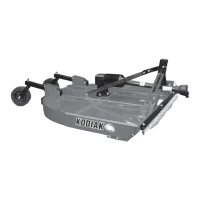OPERATION
10/11
11
SLIP CLUTCH - OPERATIONAL CHECK
The slip clutch serves as overall protection for the tractor, driveline, and gearbox. Even though new clutch assemblies
are “run-in” and checked for torque prior to shipment, re-adjustment may be advisable if the clutch has been exposed to
weather for an extended period of time. The clutch facing and plates should be inspected for rust and/or corrosion. After
implement has been stored for 30 days or more, perform the following operational check:
1. Make a trial run in the heaviest operating conditions expected. If the clutch slips noticeably, tighten the 8 adjusting
bolts no more that 1/2 turn between trial runs until the clutch slippage is reduced.
2. Scribe a mark across the clutch facing. When subjected to shock loads, a separation of the marks will assure that
clutch setting is correct. NOTE: Check the clutch periodically during the rst hour of operation for excessive
heat build-up to undetected slippage.
If the clutch is being rebuilt (new facing and/or plates), it is necessary to “run-in” these parts prior to nal adjustment. The
plates should be thoroughly cleaned and free of foreign material, as well as being checked with a straight edge for warp-
ing. Warped plates cannot be adjusted properly and will not hold. To accomplish the “run-in” after assembly, follow the
procedure below:
1. Tighten all adjusting bolts evenly until the clutch cannot be slipped by hand.
2. With the blade carrier locked in a stationary position, operate with the PTO at idling speed (approx. 100 rpm) until
evidence of heating is noted. IMPORTANT: DO NOT ALLOW THE CLUTCH TO OVERHEAT.
3. Discontinue operation and allow the clutch to cool completely. This is very important.
4. After the clutch has cooled, tighten all the adjusting bolts down evenly and proceed with regular clutch adjusting
procedures as described above.
IMPORTANT
DO NOT OVERTIGHTEN NUT AND CAUSE SPRING TO
BECOME SOLID, AS THIS WILL CAUSE SHAFT TO FAIL.
CLUTCH SPRING LENGTH CHART
EG / Comer
1.27” (32.2mm)
1.28” (32.4mm)
Bondioli & Pavesi
1.15” (29.3mm)
1.12” (28.5mm)
SLIP CLUTCH ADJUSTMENT
The slip clutch is factory preset to the correct torque for protecting implement
and tractor. Periodic adjustment is recommended. Should adjustment be
needed, rst check to be sure all spring lengths are the same. Initial spring
length is shown on chart below. If necessary, adjust nut on any spring that is
unequal. Adjust all eight spring retaining nuts 1/3 of a turn (2 ats on a nut)
and check clutch slippage. If further adjustment is necessary, do so in 1/3
turn increments. Adjust only to provide sufcient torque to prevent slippage
under normal conditions. Occasional slippage is normal for drive train protec-
tion. If satisfactory results cannot be obtained, consult your Kodiak dealer.
CAUTION:
USE JACKSTANDS, BLOCKS AND
SAFETY SHOES WHEN PERFORM-
ING MAINTENANCE.

